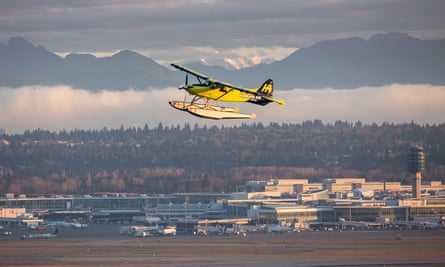The world’s largest all-electric aircraft is about to take to the skies for the first time.
The Cessna Caravan, retrofitted with an electric engine, is expected to fly for 20-30 minutes over Washington state in the US on Thursday.
The plane can carry nine passengers but a test pilot will undertake the inaugural flight alone, cruising at a speed of 114mph (183km/h). The engine maker, magniX, hopes the aircraft could enter commercial service by the end of 2021 and have a range of 100 miles.
Before the coronavirus pandemic, aviation was one of the fastest growing sources of the carbon emissions that are driving the climate emergency. Scores of companies are working on electric planes, although major breakthroughs in reducing the weight of batteries will be needed before large planes can fly significant distances on electric power alone. Other power sources being tested include hydrogen fuel cells and biofuels.

The aviation industry is heavily regulated to ensure safety but magniX hopes that by retrofitting an existing plane the certification process can be accelerated. A smaller seaplane powered by a magniX engine completed a short flight in December.
In June 2019, another company, Ampaire, flew an aircraft powered by a hybrid electric-fossil fuel engine over California. Analysts at the investment bank UBS said at the time that the aviation industry would move towards hybrid and electric engines for routes less than 1,000 miles long much more quickly than many thought.
Roei Ganzarski, the CEO of magniX, said current aeroplanes were both expensive to operate and very polluting. “Electric airplanes will be 40%-70% lower cost to operate per flight hour,” he said. “That means operators will be able to fly more planes into smaller airports, meaning a shorter and door-to-door experience, with no harmful CO2 emissions.”
Ganzarski said the company believed all flights of less than 1,000 miles would be completely electric in 15 years’ time. But he said: “Battery [energy] density is not where we would like to see it. While it is good for ultra-short flights of 100 miles on a retrofit aircraft and over 500 miles on a new design aircraft like the Alice, there is plenty of untapped potential in batteries. Now that the first commercial aircraft has flown all-electric, battery companies are starting to work more diligently on aerospace-ready battery solutions.”
Among the other companies developing electric aircraft are Zunum Aero, which is building a 27-seat plane with a 680-mile range, and the engine maker Rolls-Royce, whose Accel programme aims to produce the fastest all-electric plane to date. However, in April, Rolls-Royce and Airbus cancelled their plans for a hybrid electric aircraft. The German company Lilium is working on a five-seater jet-powered electric air taxi.
The Cessna Caravan being used by magniX is one of the world’s most used medium-range planes, with more than 2,600 operating in 100 countries. The first flight is set for 8am Pacific time (1500 GMT) on Thursday, weather permitting.
… to make a greener world. Covid-19 has delivered unusual environmental benefits: cleaner air, lower carbon emissions, a respite for wildlife. Now the big question is whether we can capitalise on this moment. The Guardian aims to lead the debate from the front.
In the weeks and months ahead, our journalism will investigate the prospects for a new green settlement. We will showcase the big thinkers and protagonists and amplify the arguments for authorities everywhere to consider as they lead us out of coronavirus.
Our credentials suit us well to the task: we are independent, we have no owners, no paymasters or oligarchs pulling the strings. We have committed to carbon neutrality, divested from the oil and gas sectors and renounced fossil fuel advertising. But at this crucial moment, news organisations like ours are facing a daunting financial challenge. As businesses everywhere feel the pinch, the advertising revenue that has long helped to sustain our work has plummeted. We need you to help fill the gap.
Our journalism is open to all because we believe everyone deserves access to factual information, regardless of where they live or what they can afford to pay. If you can afford to, we hope you will consider supporting our journalism today.
The Guardian believes that the climate crisis we face is systemic. We will inform our readers about threats to the environment based on scientific facts, not driven by commercial or political interests. We will keep reporting on the efforts of individuals and communities around the world who are fearlessly taking a stand for future generations and the preservation of human life on earth. We want their stories to inspire hope.
We need your support to keep delivering this kind of open, committed independent journalism. Every reader contribution, however big or small, is so valuable.




No comments:
Post a Comment